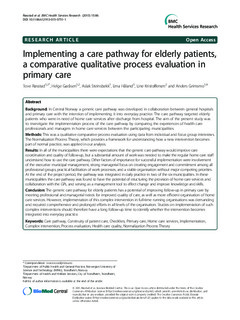Implementing a care pathway for elderly patients, a comparative qualitative process evaluation in primary care
Røsstad, Tove; Garåsen, Helge; Steinsbekk, Aslak; Håland, Erna; Kristoffersen, Line; Grimsmo, Anders
Journal article, Peer reviewed
Permanent lenke
http://hdl.handle.net/11250/2364864Utgivelsesdato
2015Metadata
Vis full innførselSamlinger
Sammendrag
Background: In Central Norway a generic care pathway was developed in collaboration between general hospitals
and primary care with the intention of implementing it into everyday practice. The care pathway targeted elderly
patients who were in need of home care services after discharge from hospital. The aim of the present study was
to investigate the implementation process of the care pathway by comparing the experiences of health care
professionals and managers in home care services between the participating municipalities.
Methods: This was a qualitative comparative process evaluation using data from individual and focus group interviews.
The Normalization Process Theory, which provides a framework for understanding how a new intervention becomes
part of normal practice, was applied in our analysis.
Results: In all of the municipalities there were expectations that the generic care pathway would improve care
coordination and quality of follow-up, but a substantial amount of work was needed to make the regular home care staff
understand how to use the care pathway. Other factors of importance for successful implementation were involvement
of the executive municipal management, strong managerial focus on creating engagement and commitment among all
professional groups, practical facilitation of work processes, and a stable organisation without major competing priorities.
At the end of the project period, the pathway was integrated in daily practice in two of the six municipalities. In these
municipalities the care pathway was found to have the potential of structuring the provision of home care services and
collaboration with the GPs, and serving as a management tool to effect change and improve knowledge and skills.
Conclusion: The generic care pathway for elderly patients has a potential of improving follow-up in primary care by
meeting professional and managerial needs for improved quality of care, as well as more efficient organisation of home
care services. However, implementation of this complex intervention in full-time running organisations was demanding
and required comprehensive and prolonged efforts in all levels of the organisation. Studies on implementation of such
complex interventions should therefore have a long follow-up time to identify whether the intervention becomes
integrated into everyday practice.
